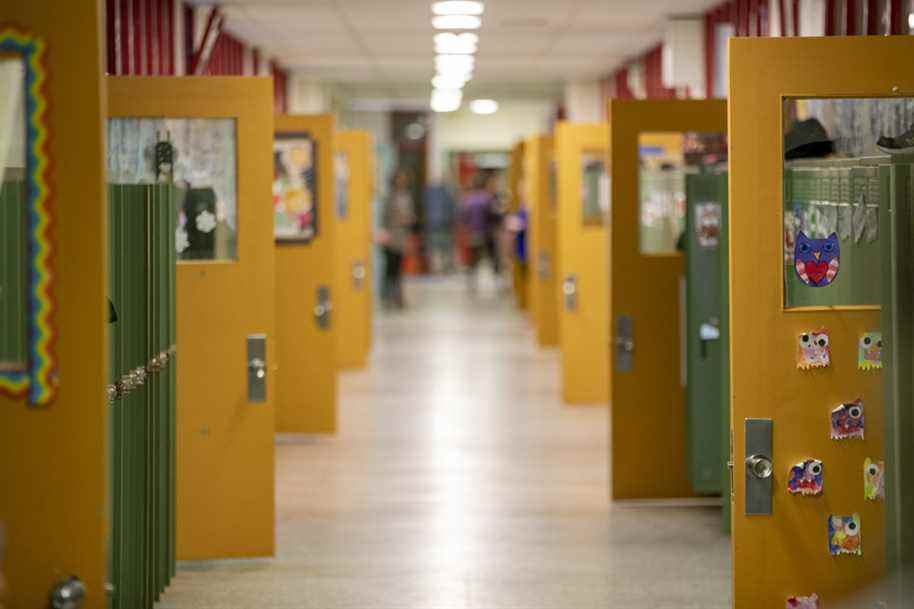Unlike British Columbia, Ontario and New Brunswick, the Quebec government has not yet disclosed how much it has spent to improve ventilation and air quality in schools since start of the COVID-19 pandemic.
Posted at 5:00 a.m.
It will probably cost more in Quebec to improve air quality, since 54% of its public schools do not have a mechanical ventilation system. This is a much higher ratio than in other provinces.
Three provinces have confirmed to The Press the amount of their investments in ventilation in their schools since the fall of 2020: 122 million for British Columbia, 600 million for Ontario and 13 million for New Brunswick1. Some of the provinces had already made this figure public before the request for The Press.

In January, the Legault government said it had invested “hundreds of millions of dollars” since the start of the pandemic to improve air quality in schools, without giving a precise figure. Quebec promised to take stock of these expenses during “the next few months”.
“Air quality is such an important issue for our government that an announcement will be made on this subject very soon,” said Tuesday by email the office of the Minister of Education, Jean-François Roberge. The Ministry of Education also affirmed that “the actions taken for air quality and the related expenses will be revealed soon”.
What we know for now: Quebec has used 20 million of the 432 million dollars paid by the federal government in the fall of 2020 for the breakdown to ensure a safe return to school despite COVID-19. The ventilation was one of the priorities of the federal program, but the provinces could spend the money “according to their priorities in education”, according to Ottawa. Quebec had also granted 190 million to school service centres; it is possible that part of this sum was used to improve ventilation.
More than half of public schools without mechanical ventilation
In theory, the bill for improving air quality could be much higher in Quebec than in other provinces.
The reason: there are more schools without a mechanical ventilation system.
About 54% of public schools in the province do not have a mechanical ventilation system, compared to 20% of public schools in New Brunswick and less than 5% in British Columbia2.
In general, a mechanical ventilation system is the best solution in terms of air quality in schools – which in particular makes it possible to reduce the spread of COVID-19 there. You can also install an air exchanger, open windows and doors, or install an air purifier to improve the air quality in a classroom. However, experts do not all agree on the best of these three measures. These corrective measures usually take place in schools without mechanical ventilation. For example, Ontario and New Brunswick have installed air purifiers in their classrooms without mechanical ventilation.
A mechanical ventilation system “is the best solution for the moment at a reasonable cost, says virologist Benoit Barbeau, professor at UQAM. Opening the windows is also a good way to circulate the air. The important thing is to circulate the air constantly so that poor quality air does not stagnate in the same room”.
For its part, Quebec plans to have finished installing CO readers.2 in its 90,000 classes by the end of February. At the end of January, these readers were already all operational in the 52,000 classes without mechanical ventilation – the classes most at risk. From 1500 ppm CO2 in a class, Quebec believes that corrective measures must be taken, whether it be opening the windows more or installing an air exchanger.
How much did Quebec spend before the pandemic?
Quebec also did not want to indicate what it spent to improve ventilation and air quality in schools in the three years preceding the pandemic, that is from 2017-2018 to 2019-2020.
Does the Ministry of Education know how much it has spent on improving air quality in schools in each of the past five years?
When asked about the annual total spent on work “to correct mold and air quality problems in schools”, the Ministry of Education replied that “these amounts are not available in such detail because the information is not available.
However, Quebec specifies that it knows “the height of the announced investments which are [destinés] to air quality”. What are these amounts for the years 2017-2018 to 2021-2022? The Ministry of Education indicates that these expenses “will be revealed soon”.
Each year, as part of the study of budget appropriations, the Ministry of Education reveals how much it spends in total to renovate its infrastructure, mainly schools. The Ministry of Education spent 1.185 billion to maintain its infrastructure stock in 2019-2020 and planned to spend 762 million in 2020-2021 as well as 1.475 billion in 2021-2022. However, these expenses are not broken down precisely enough to know the amount devoted to ventilation and air quality.
1. The Press reported this information to five provinces, the four largest (Ontario, Quebec, British Columbia, Alberta) and New Brunswick, a neighboring province of Quebec. Alberta responded, but did not provide a specific total figure. She said that of the $250 million in additional funding given to school authorities in 2020, at least $44 million was spent on improving ventilation systems, according to available data.
2. British Columbia does not have a province-wide figure, but relies on a survey of 20 of its 60 school boards.

